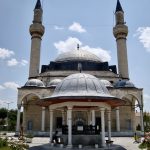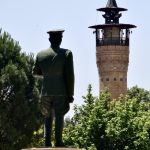For those of an adventurous disposition South-Eastern Turkey is usually the destination of choice. An oblique rectangle with its corners turning on Malatya, Gaziantep, Van and Hakkari, it’s a huge area where every day is bound to throw up surprises. Things won’t always go as smoothly as you planned, and communication can sometimes be tricky in a region where Turkish is often a second language for native Kurdish or Arabic speakers but the rewards for perseverance will more than make up for any difficulties along the way.
This part of the country is home to many iconic sights from the great Commagenian heads on Nemrut Dağı (Mt Nemrut) through the restored Armenian church at Akdamar on Lake Van to the great Roman mosaics of Gaziantep and Şanlıurfa. Ringed with dramatic mountains, Van Gölü is a spectacular inland lake, while the enormous Atatürk Dam and the associated works of the GAP (South-East Anatolia) Project have given rise to a string of man-made lakes stretching from Şanlıurfa to Elazıg. Hundreds of minor sites receive almost no visitors.
Although the security situation in the east is much better than in the past it can worsen at short notice. Check the latest travel advisories before visiting the Siirt-Şırnak-Hakkari area. The part of the south-east reaching as far as Diyarbakır was also impacted by the 2023 earthquakes, if not quite as badly as the area around Antakya and Kahramanmaraş.
Getting there
The great distances mean that it’s wise to make use of the airports at Gaziantep, Şanlıurfa, Diyarbakır, Mardin and Van to get to and from the region. Once there you can easily get around in comfortable inter-city buses and minibuses. The timetable of the ferry across Lake Van from Tatvan to Van is a secret known only to its operators. You’ll probably have more luck with the one across Lake Atatürk from Siverek to Kahta.
Dominated by a castle that is a cut-down version of the now inaccessible one across the border in Aleppo (but sadly damaged by the 2023 earthquakes), Antep is a boom town which looks unnervingly modern as you drive into it but then turns out to be hoarding some wonderful old houses and dramatic black-and-white-striped churches. Stay at the lovely Anadolu Evleri hotel to get the feel for life as it would have been lived in the 19th century, then pop into the nearby İmam Çagdaş restaurant and tuck into spicy Adana kebaps with the locals, rounding off your meal with some of the delectable sticky baklava for which the town is famous.
Not as overtly welcoming as Antep, Urfa is famous as the presumed birthplace of the Prophet İbrahim which makes it a pilgrimage destination for visitors from around the Middle East. The Gölbaşı area around the cave where he was born is beautifully landscaped and ringed with historic buildings constructed in a lovely golden-brown stone. Make sure you leave time to plunge into one of Turkey’s most authentic old bazaars with, at its heart, a glorious courtyard shaded by plane trees where men pass the day playing tavla (backgammon) and sipping çay.
Dubbed the eighth wonder of the world by over-enthusiastic travel agencies, Nemrut Dağı is certainly a must for every visitor to the south-east. The mountaintop here was turned into a gigantic tomb by the megalomaniac king Antiochus I Commagene who had statues of the gods carved around it. Toppled by a later earthquake, these now stand in picturesque disarray, awaiting visitors who trek up at dawn and dusk to experience the sunrise and sunset; come in the middle of the day to have the site to yourself, and try and book on a tour that takes in the outlying ruins too. Sadly, Kahta, the little town at the foot of the mountain, is not much to write home about. Nearby Adiyaman is calmer but big and business-oriented. Alas, it was badly damaged by the 2023 earthquakes.
Once notorious as the heart of the Kurdish resistance, Diyarbakır is now a much less tense town to visit despite the brooding basalt walls that ring its historic centre. A great deal of renovation has taken place, and the once neglected Hasanpaşa Han now makes a wonderful place to hang out and watch the world go by after a visit to the magnificent Ulu Cami across the road. It’s easy to get lost in the warren of back streets around the mosque but with luck you’ll stumble on some of the old churches and huge houses that are open to the public as museums. Watch your bag when walking around the remoter stretches of the walls.
Everyone’s favourite south-eastern town, Mardin is a place of honey-gold houses and minarets with huge stone teardrops on their sides. The market is vibrant and colourful – come here to buy images of the Şahmaran (a fertility figure) created under glass and huge roundels of olive-oil soap. At the nearby Derulzafaran monastery services are still held in Aramaic, the language of Jesus, as they are at Mor Gabriel near Midyat, a less visited version of Mardin built on flatter ground. Mardin’s ever-growing number of boutique hotels struggles to keep up with demand. Book ahead to be on the safe side.
In a great location right on Lake Van, Van itself is an ugly modern town with little to recommend it bar the ruins of Van Kalesi, a Urartian castle on a dramatic plug of rock. The town is famous for its extravagant breakfasts; tuck into one at Bak Hele Bak Yusuf Konak Kahvaltı and Kültür Sarayı and the experience may live on in your memory longer even than the castle, especially now that that has been partially rebuilt.
Recently restored to much acclaim, the delightful 10th-century church on Akdamar island on the south side of Lake Van was once the focal point of the capital of a long-lost Armenian kingdom. You’ll probably remember the church as much for the beauty of its setting as for the extraordinary carvings of biblical stories on its facade.
It may be Turkey’s apricot capital and one starting point for a trip up Nemrut Dağı but Malatya is mainly a modern town of concrete high-rises. The old settlement of Battalgazi (Eski Malatya) has all the medieval monuments modern Malatya lacks. Malatya was terribly damaged in the 2023 earthquakes.
The historic houses and mosques of Maraş used to keep a low profile behind the high-rises. Its super-thick ice-cream may be a sensation but these days you can sample it in branches of Mado countrywide. Maraş, too, was devastated by the 2023 earthquakes. I don’t know how much of the old town survived.
The beehive houses are remarkable and the ruins of the country’s oldest university fascinating but Harran, due south of Urfa, has always been a hassley village to visit.
At Birecik between Antep and Urfa a road runs north to Halfeti where you can take a boat through a gorge to visit the remains of Rumkale (Greek Castle) high on a rock above the Fırat (Euphrates). The boat also glides past a drowned village whose minaret juts up from the water, a curious and evocative sight. Rumkale itself was closed for restoration for much of the 2010s. It may have reopened by the time you read this.
A Mardin in miniature, pretty little Savur receives far fewer visitors even though it’s just a short bus ride away. Come here to savour the honey-gold houses in peace and quiet.
On the north shore of Lake Van, Ahlat is famous for a cemetery of elaborately carved tombstones dating from the 17th century. Walk through it and downhill to discover the picturesque ruins of old Ahlat and Cappadocia-style cave dwellings including one with stalactites carved over its entrance.
Once well off the beaten track inland from the western end of Lake Van, Bitlis is slowly opening up to tourism and turns out to have a fine array of sturdy stone-built houses as well as several mosques with extraordinarily beautiful minarets.
In the far south-eastern corner of Turkey abutting the borders of Iran and Iraq, Hakkari has not always been accessible to outside visitors since the 1990s. The modern town has little to offer bar a glorious setting surrounded by mountains but, should the security situation allow exploration, there are many off-the-beaten-track villages nearby whose abandoned churches and other ruins go almost unrecorded.
Hasankeyf on the banks of the Dicle (Tigris) river used to be one of the great highlights of this part of Turkey. However, in 2020 the opening of the Ilısu Dam flooded the lower part of the settlement. Many of its hugely important historic monuments were moved into an archaeological park and I assume that those on high ground will become accessible by boat as at Rumkale but have not yet been back to see for myself.

